MARIANI’S
Virtual
Gourmet
February
5, 2023
NEWSLETTER
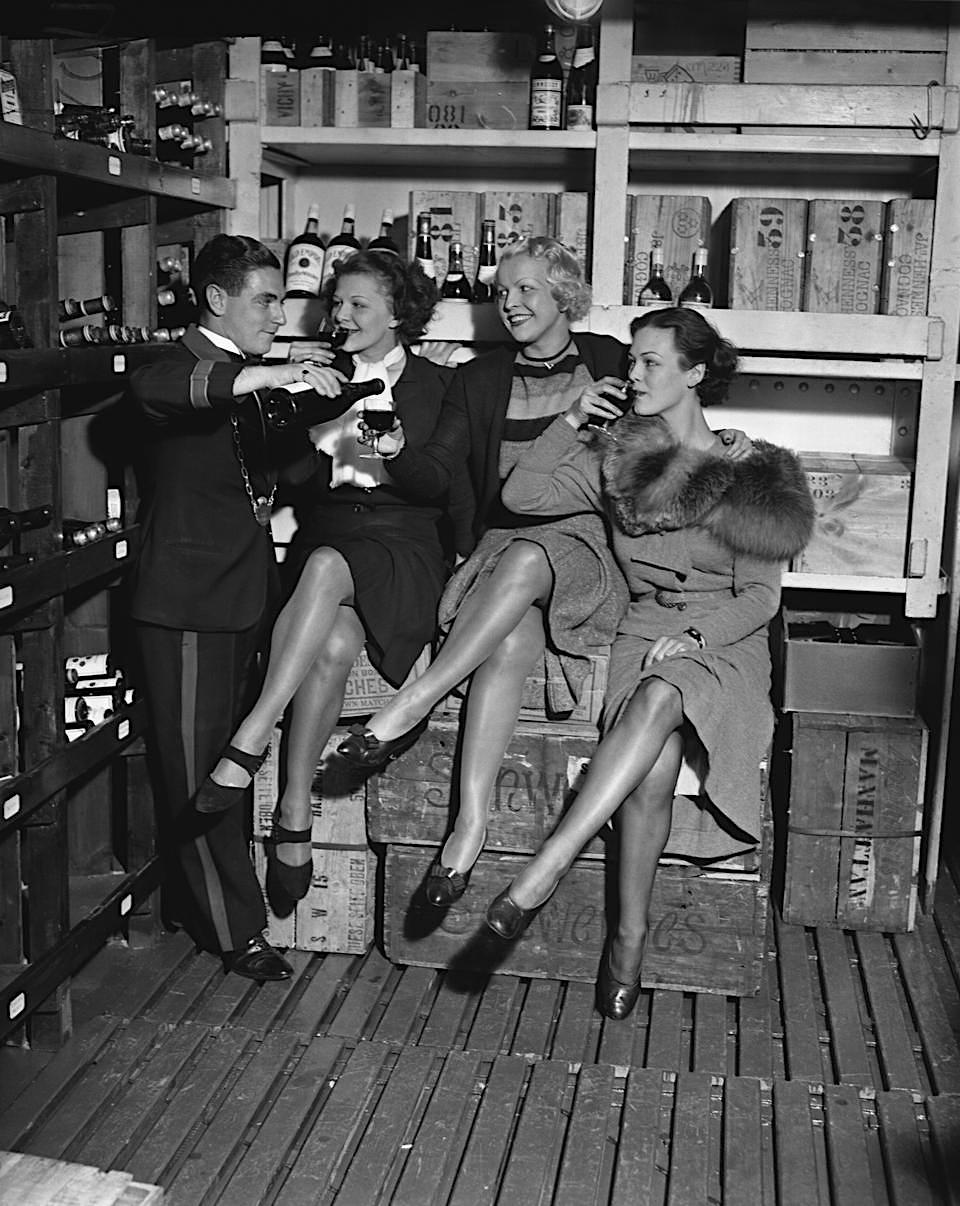
❖❖❖
THIS WEEK
POLIGNANO A MARE IS A SMALL GEM
OF A TOWN IN PUGLIA
By John Mariani
NEW YORK CORNER
ESSENTIAL BY CHRISTOPHE
By John Mariani
GOING AFTER HARRY LIME
CHAPTER SIX
By John Mariani
NOTES FROM THE WINE CELLAR
US WINE SALES' FUTURE SHOWS
HEADWINDS AND TAILWINDS
By John Mariani
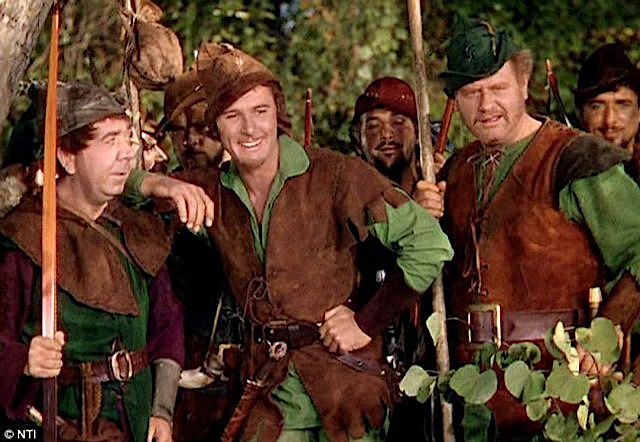 Carlson
on WHAT THE MIDDLE AGES WAS REALLY LIKE.
Go to: WVOX.com.
The episode will also be archived at: almostgolden.
Carlson
on WHAT THE MIDDLE AGES WAS REALLY LIKE.
Go to: WVOX.com.
The episode will also be archived at: almostgolden.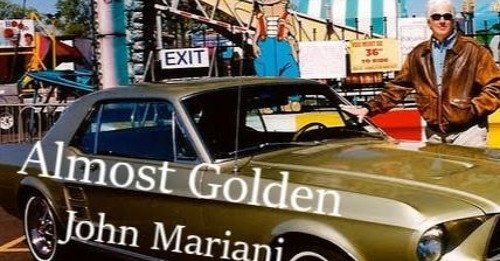
OF A SOUTHERN ITALIAN TOWN
By John Mariani
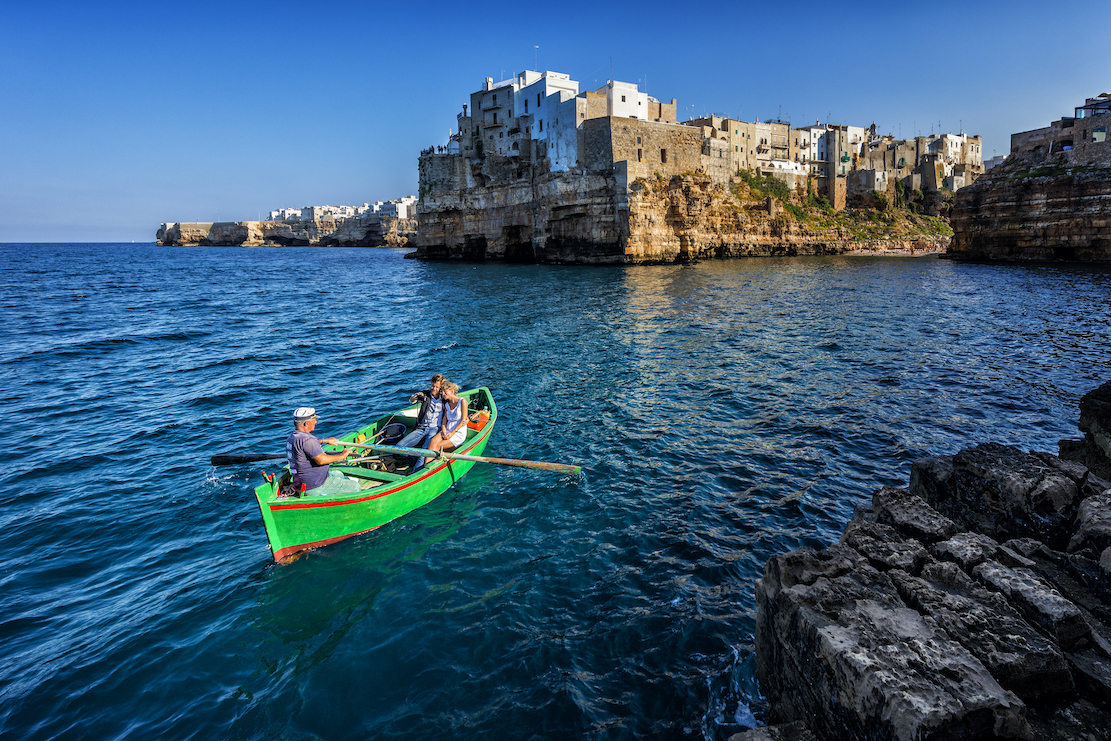
The Harbor at Polignano a Mar
The Italian peninsula is
neither very long (736
miles) nor very wide (150 miles), not counting
Sicily, so that the distance from one town to
another may be less than five miles, yet they
all have their unique charms, which differ
radically from the foggy north to the
sun-kissed south.
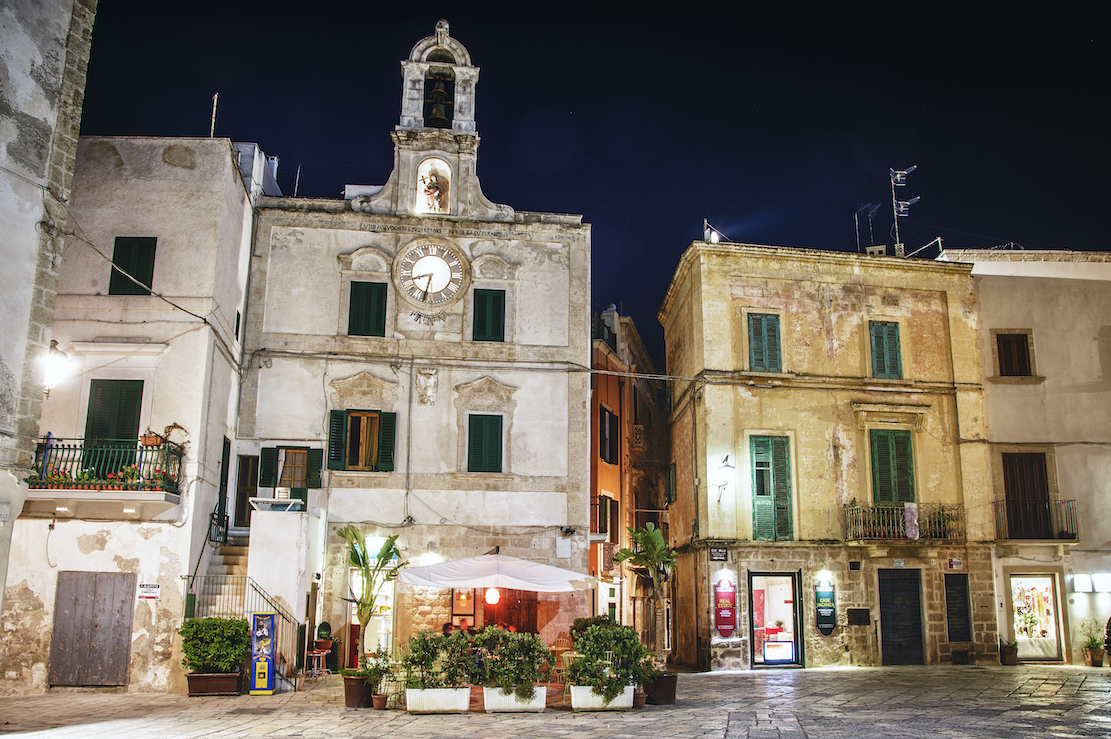 As
a seaside province on Italy’s heel, Puglia has
the Adriatic on one side and the Tyrrhenian on
the other, accounting for 500 miles of coastline
corrugated with harbors and inlets. Forty
minutes south of the large city of Bari is the
small city of Polignano Mare and fifty minutes
away is Monopoli, both of which can be visited
in a day. From there other days can be languidly
spent visiting Ostuni, Brindisi, Lecce and
Gravina.
As
a seaside province on Italy’s heel, Puglia has
the Adriatic on one side and the Tyrrhenian on
the other, accounting for 500 miles of coastline
corrugated with harbors and inlets. Forty
minutes south of the large city of Bari is the
small city of Polignano Mare and fifty minutes
away is Monopoli, both of which can be visited
in a day. From there other days can be languidly
spent visiting Ostuni, Brindisi, Lecce and
Gravina.
Polignano a Mare has a shadowy history,
with some scholars claiming the Greeks settled
it as Neapolis, while others say Julius Caesar
founded it as a hub along the Via Traiana. Its
situation on the Adriatic was a double-edged
sword, on the one hand making it readily
accessible for trade, on the other easy to
invade. Thus, its occupiers have included the
Byzantine Empire, the Normans, the Angioinians
and the Aragonese, who pretty much stabilized
the region.
On the way into
town, stop to visit the Museum of
Contemporary Art Pino Pascali (below)
on the Parco du Santo Stefano, a squat building with a Roman archway housing a
remarkable array of the native artist’s work
(along with a few others’) in every type of
medium, from painting to sculpture to fabric to
video. Opened in 2012, it pays homage to an
artist who died in Rome at 33, yet who achieved
international renown within the avant-garde
community.
squat building with a Roman archway housing a
remarkable array of the native artist’s work
(along with a few others’) in every type of
medium, from painting to sculpture to fabric to
video. Opened in 2012, it pays homage to an
artist who died in Rome at 33, yet who achieved
international renown within the avant-garde
community.
 Polignano
is such a pleasure to stroll through, for there
really isn’t a lot of area to cover. Despite
that, indeed, because of it, the town swells
with tourists in summer, especially for the “Red
Bull Cliff Diving Polignano” event that draws
50,000 people annually to watch professional
divers plunge 65 feet into clear blue waters
edged with rocky cliffs. The seashore is also
pockmarked with grottoes in which the sea ebbs
and flows, one of which, Grotta Palazzese, now
holds a fine dining restaurant.
Polignano
is such a pleasure to stroll through, for there
really isn’t a lot of area to cover. Despite
that, indeed, because of it, the town swells
with tourists in summer, especially for the “Red
Bull Cliff Diving Polignano” event that draws
50,000 people annually to watch professional
divers plunge 65 feet into clear blue waters
edged with rocky cliffs. The seashore is also
pockmarked with grottoes in which the sea ebbs
and flows, one of which, Grotta Palazzese, now
holds a fine dining restaurant.
If you stroll along the Lungomare
(waterfront), with its narrow streets
weaving in and out of the Old Town,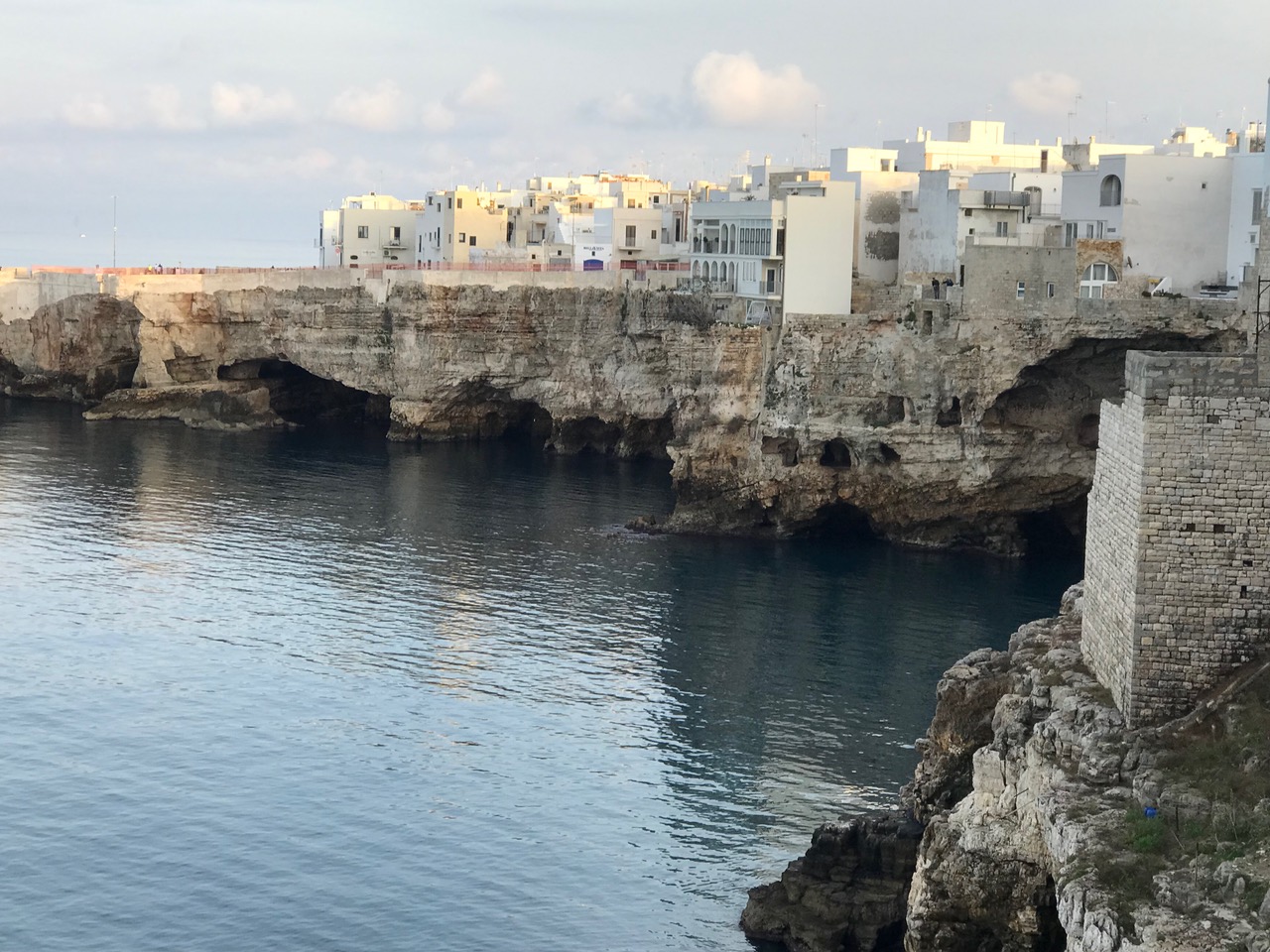 where
people live in perched apartments and new
boutiques and trattorias have popped up, you
will eventually come to the statue of local boy
Domenico Modugno, who became an international
star with his song “Volare.”
where
people live in perched apartments and new
boutiques and trattorias have popped up, you
will eventually come to the statue of local boy
Domenico Modugno, who became an international
star with his song “Volare.”
The beaches below may be rocky or white
sand, small and secluded, the most famous of
which, the secluded Lido Cala Paura (above), can be
viewed from the old bridge above.
There are, of course, numerous churches
to drop into, the finest of which is devoted to
Santa Maria Assunta in Piazza Dell’Orologio,
consecrated in 1295 with a simple bell tower
and housing Stefano da Putignano’s beloved
Nativity sculpture (1530).
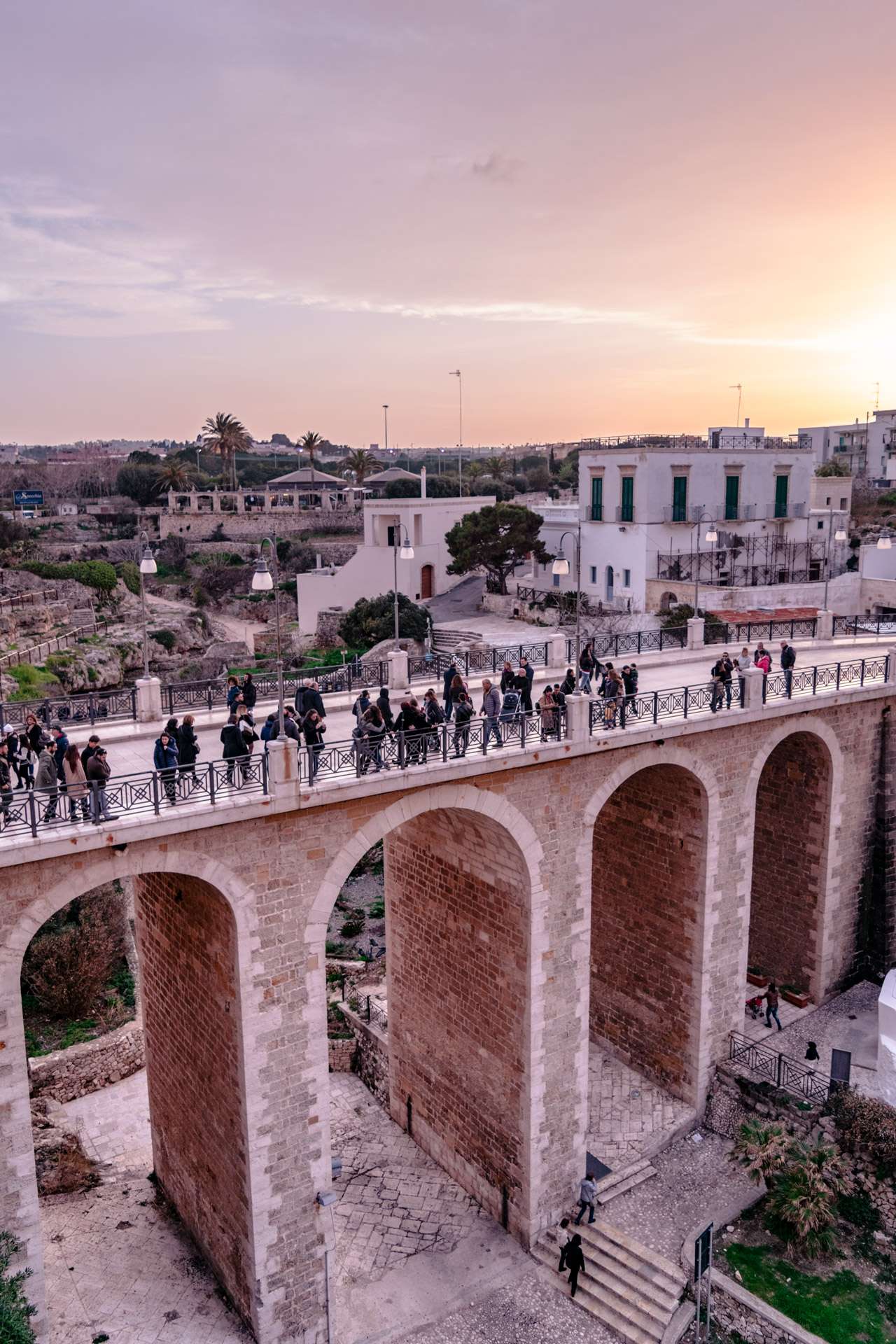 Given its history and various
occupiers, Polignano’s architectural diversity
can be seen in the palazzos, the terraced
Governor’s palace, and, on the expansive Piazza
Vittorio Emanuele II, the Palazzo dell’Orologio,
seat of the town hall until 1837.
Given its history and various
occupiers, Polignano’s architectural diversity
can be seen in the palazzos, the terraced
Governor’s palace, and, on the expansive Piazza
Vittorio Emanuele II, the Palazzo dell’Orologio,
seat of the town hall until 1837.
Sitting along the main street, just shy
of the Lama Monachile bridge (left), are
several good spots to eat and drink. By all
means you must have a cup of Polignano’s caffe
speziale, made with espresso laced with
amaretto liqueur. A good spot to try it is the
oddly named FCAZZ Birra, with outdoor tables set
under white umbrellas.
Just across the street is one of the
region’s finest seafood restaurants, Casa
Mia, on the Piazza Garibaldi (below).
A smart looking place with outdoor tables,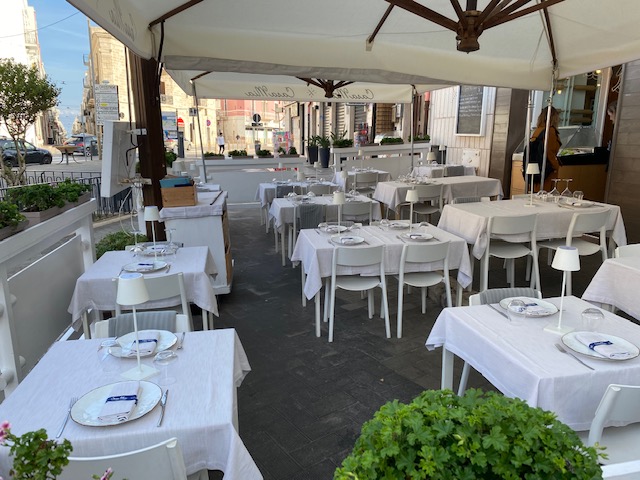 it has a fine wine list and ebullient owners in
Vito and Michele Dragone. There
you might want to start off with a puffy-crusted
pizza, but the antipasti, including crudi of
mackerel (below) and shellfish, are
difficult to ignore.
it has a fine wine list and ebullient owners in
Vito and Michele Dragone. There
you might want to start off with a puffy-crusted
pizza, but the antipasti, including crudi of
mackerel (below) and shellfish, are
difficult to ignore.
The menu changes with the tide, and
whatever comes in fresh that morning will be on
it: red shrimp with fried artichokes; tuna with
pesto; spaghetti with seppie and
a puree of yellow squash; tortelletti
with scampi and basil. The fritto
misto of seafood is impeccably cooked. The
best way to appreciate Casa Mia is with a
tasting of either three or six dishes, priced
according to the day’s market.
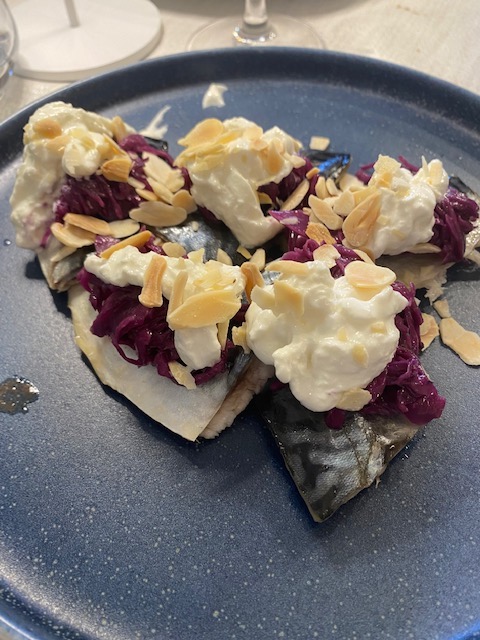 If you end the
afternoon early, you can also visit nearby Monopoli,
a town blessed in legend by the visitation of
the Madonna in 1117, arriving on a raft, as
commemorated at the Cathedral di Maria
Santissima della Madia (below). This is a
medieval town,
If you end the
afternoon early, you can also visit nearby Monopoli,
a town blessed in legend by the visitation of
the Madonna in 1117, arriving on a raft, as
commemorated at the Cathedral di Maria
Santissima della Madia (below). This is a
medieval town,  settled in
the sixth century (although it is said pirates
built a small church, San Salvatore, there
in 313 in thanks for surviving a shipwreck),
dominated by a fortress of Charles V, the
Spanish king who kept the peace that led to
Monopoli’s being free of further invasion.
settled in
the sixth century (although it is said pirates
built a small church, San Salvatore, there
in 313 in thanks for surviving a shipwreck),
dominated by a fortress of Charles V, the
Spanish king who kept the peace that led to
Monopoli’s being free of further invasion.
Sunsets
over the Adriatic offer dramatic vistas that
indicate just how close the town is to the Near
East. Then it’s time to walk through the small
streets, all well-lighted to show off the
whitewashed cleanliness of the city’s homes, as
the people of Monopoli close their shutters and
light their lamps.
NEW YORK CORNER
By John Mariani
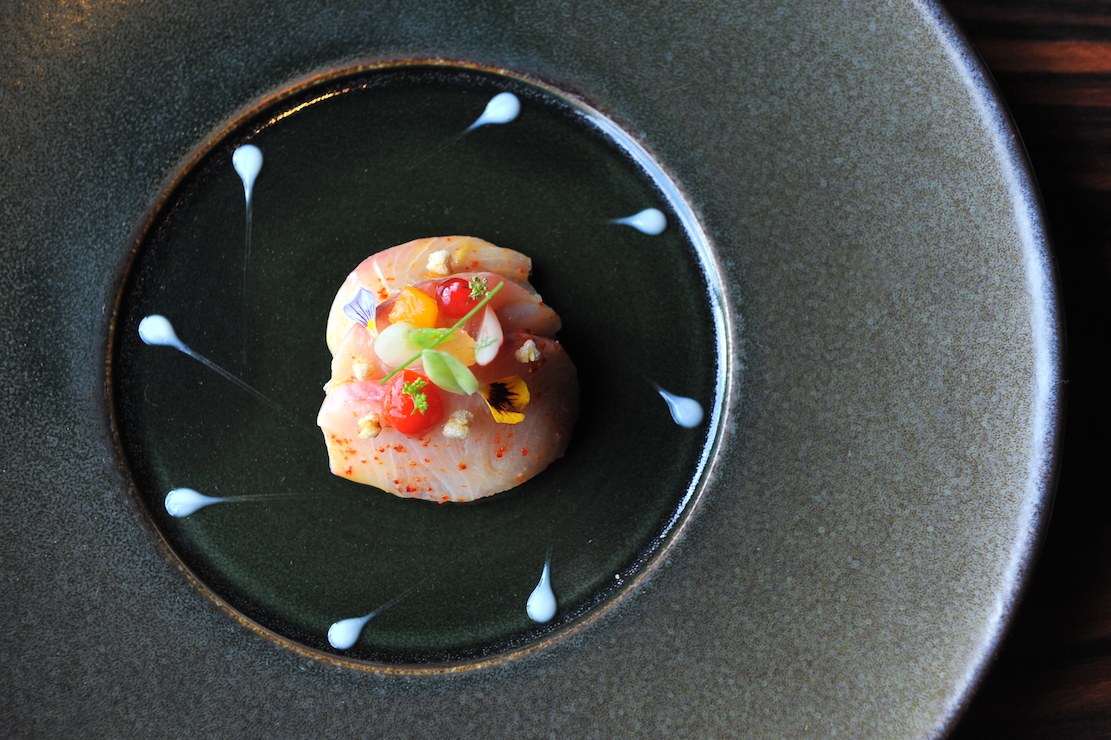
Back
when I was compiling my annual “The Best New
Restaurants of the Year” for Esquire,
a few times over thirty-five years, as soon as
I entered a place I sensed that it was going
to be quite out of the ordinary and a prime
contender for the list. Pulling open the iron
doors of
Christophe Bellanca’s new restaurant
across from the Museum of Natural History, I
had a very keen sense that would be the case,
and throughout the next few hours there, I
never wavered from that first impression.
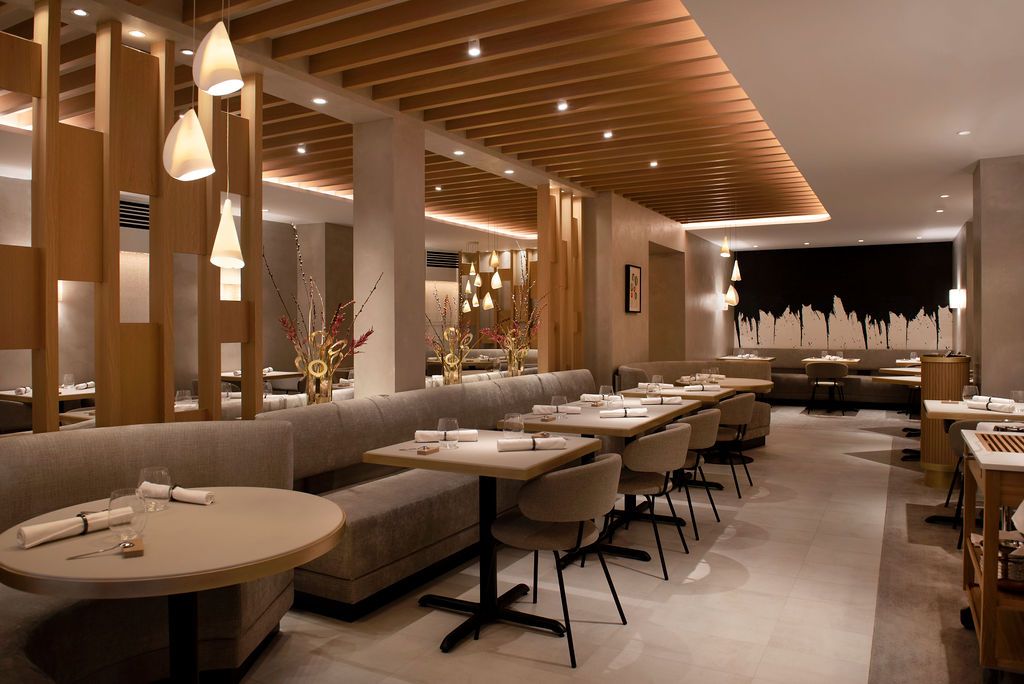 On looks
alone, Parisian interior designer Caroline
Egasse’s interiors show a sophisticated
restraint as well-crafted as a Chanel jacket and
skirt ensemble, even evoking the pale colors of
taupe, black and white that epitomize a style
that never goes out of fashion. Even though I
bewail restaurants without tablecloths, the
soft, padded, treated leather used in Essential
is really quite beautiful and the lighting
allows you to see everyone, easily read the menu
and appreciate the color and presentation of the
food set
On looks
alone, Parisian interior designer Caroline
Egasse’s interiors show a sophisticated
restraint as well-crafted as a Chanel jacket and
skirt ensemble, even evoking the pale colors of
taupe, black and white that epitomize a style
that never goes out of fashion. Even though I
bewail restaurants without tablecloths, the
soft, padded, treated leather used in Essential
is really quite beautiful and the lighting
allows you to see everyone, easily read the menu
and appreciate the color and presentation of the
food set 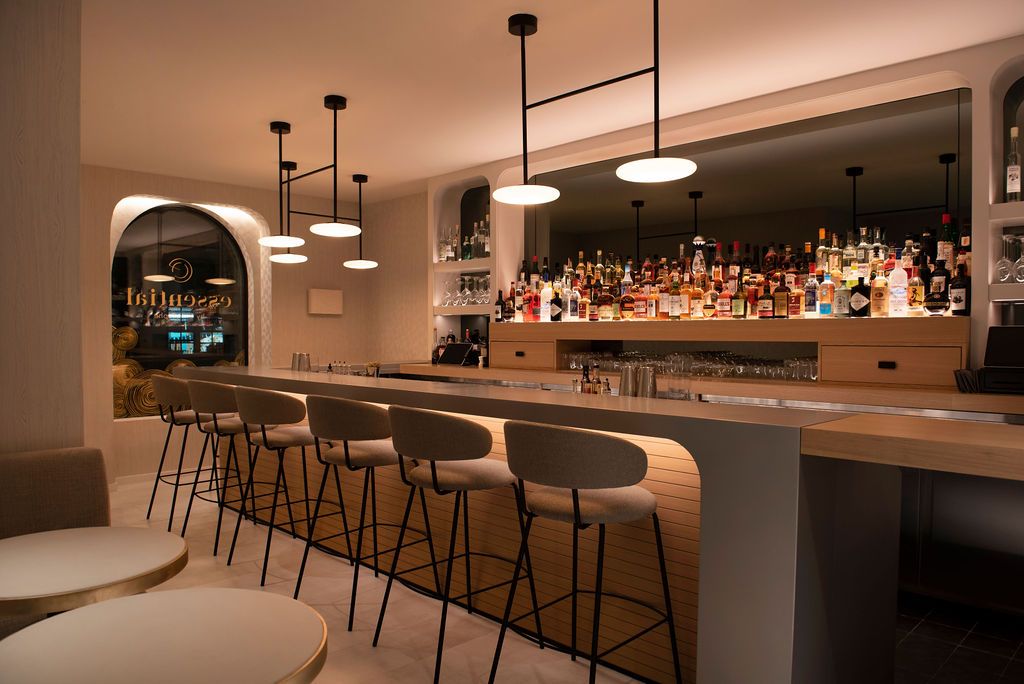 on Bernardaud
china.
on Bernardaud
china.
In addition, when this space was called
Dovetail its hard wooden walls caused a sheer
cacophony; now, with soft, subtly textured
surfaces throughout, this is as civilized a
dining room as I’ve been to in quite some time,
reminding me of similar rooms at modern
restaurants in Paris. There are touches of leather, brass, porcelain
tiles and Élitis wallpapers, with the
counterpoint of a bold blue vinyl and silk
mural. A 16-seat outdoor patio will also be
available for neighborhood folks to enjoy with
friends and family as the seasons permit.
The attractive, largely female staff,
from the host station to the bar and split
dining rooms, are all well dressed in black
(though t-shirts on the busboys seems out of
character). General Manager Adrien Falcon sets a
tone of casual hospitality, and beverage
director Andrea Morris is every bit as helpful
in assisting you to choose the right wine.
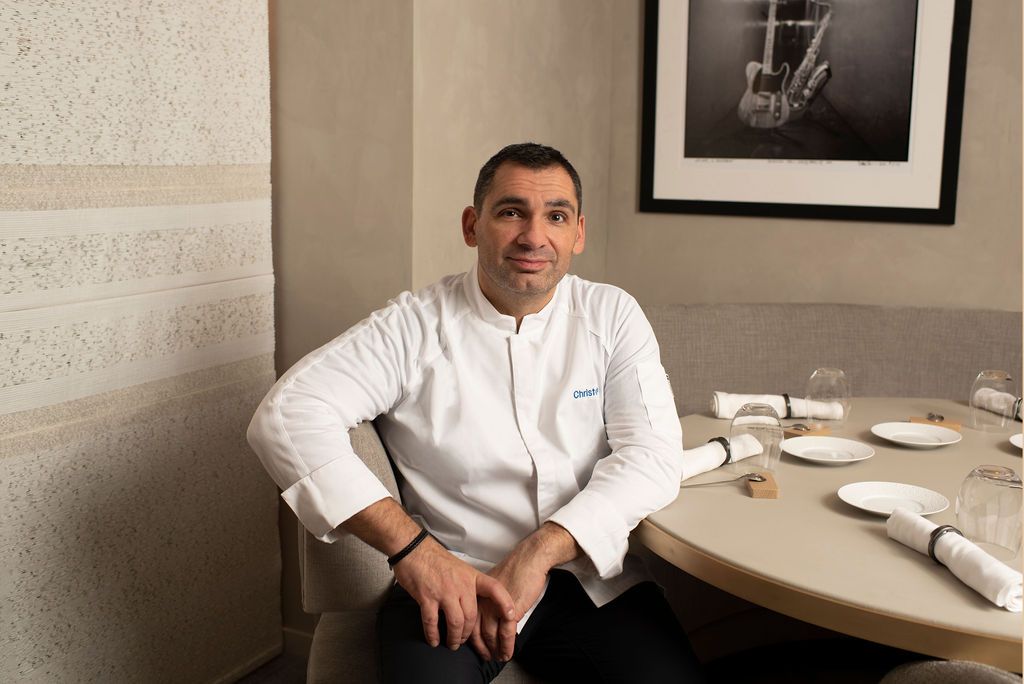 The restaurant’s guiding motto is “To be
creative is simple but to understand what is
simple can take a lifetime,” which is in line
with the credo of the late master chef Joël
Robuchon, at whose New York restaurant L’Atelier
Bellanca had been chef de cuisine, and you can
see the lineage of those menus in his own
cooking. (He had also been chef at L’Orangerie
in Los Angeles and Le Cirque in New York.)
The restaurant’s guiding motto is “To be
creative is simple but to understand what is
simple can take a lifetime,” which is in line
with the credo of the late master chef Joël
Robuchon, at whose New York restaurant L’Atelier
Bellanca had been chef de cuisine, and you can
see the lineage of those menus in his own
cooking. (He had also been chef at L’Orangerie
in Los Angeles and Le Cirque in New York.)
Among
New York French restaurants, Bellanca’s cooking
is closest to Eric Ripert’s at Le Bernardin,
though the latter is entirely focused on
seafood, where very little is done to the main
ingredients but to put them all in balance.
Bellanca’s is less fussy than Daniel Boulud’s,
less lavish than Gabriel Kreuther’s and far more
innovative than the tradition-bound La
Grenouille. And it is wholly his own.
The à la carte menu has four sections,
and, since prices are remarkably moderate, one
is tempted to choose from all four, including
dessert. (There is also a bar menu with nothing
over $18, including a cheeseburger and fries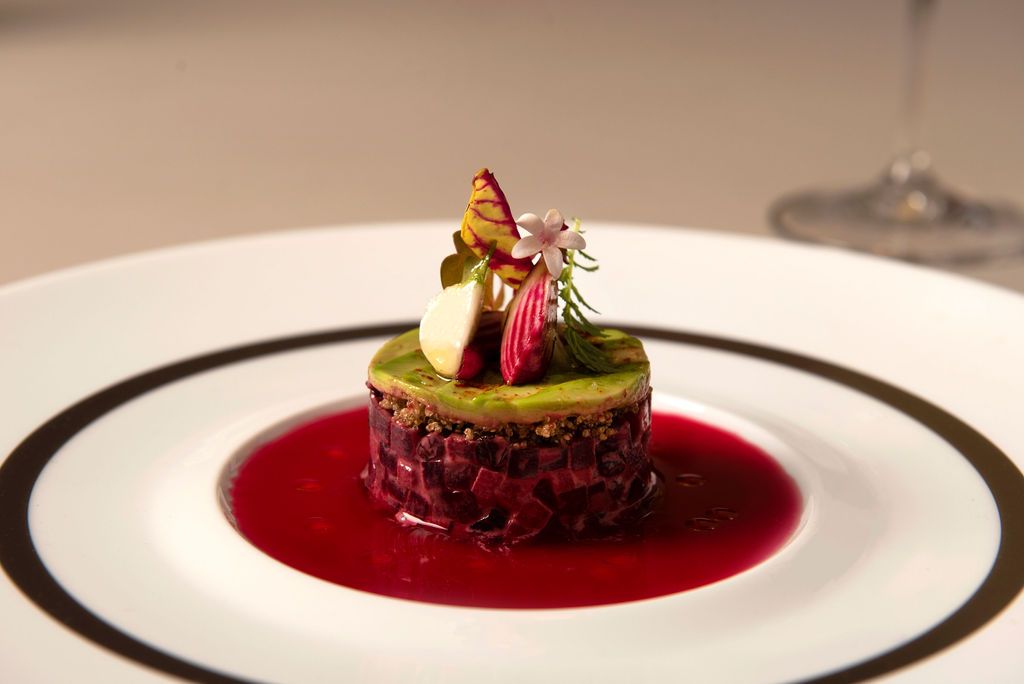 that anywhere else would run you $25 and up.)
You will begin with a complimentary amuse
bouche, like warm mushroom cappuccino with sweet
potato and a reduction of Madeira wine.
that anywhere else would run you $25 and up.)
You will begin with a complimentary amuse
bouche, like warm mushroom cappuccino with sweet
potato and a reduction of Madeira wine.
We chose smooth, creamy foie gras with a
lovely apple/cranberry confit and Pineau des
Charentes fortified wine ($29), which made a
nice balance with the hiramasa
sashimi with avocado, black radish and tangy
fresh yuzu
($18). A beautiful rendition of beetroot that
had been lightly smoked (which somewhat
compromised its natural earthy flavor) came with
barberry, crispy amaranth and a nice touch of
Upper West Side tradition—borscht ($18).
Some of the best,
sweetest sea scallops of the winter came with
the fine texture of Savoy cabbage and a black truffle emulsion
one can never tire of in French cuisine ($28),
while eggplant was glazed and served with smoked
yogurt and a vegetable curry ($18), which
reflects tastes Bellanca picked up when he
cooked at Robuchon’s restaurants in Hong Kong
and Macao.
Among the main courses a perfectly cooked
wild black bass revealed just how wonderful this
species is, braised and sided with shiitake
chutney, razor clams and a turmeric emulsion
($38). I had my first venison of the new year
here and it was superb, nicely gamey, simply
grilled and served with coco bean and the sea
plant salicorne, with a punch of grain mustard
($46). Duck also seemed a capital idea for a
January evening, and it came 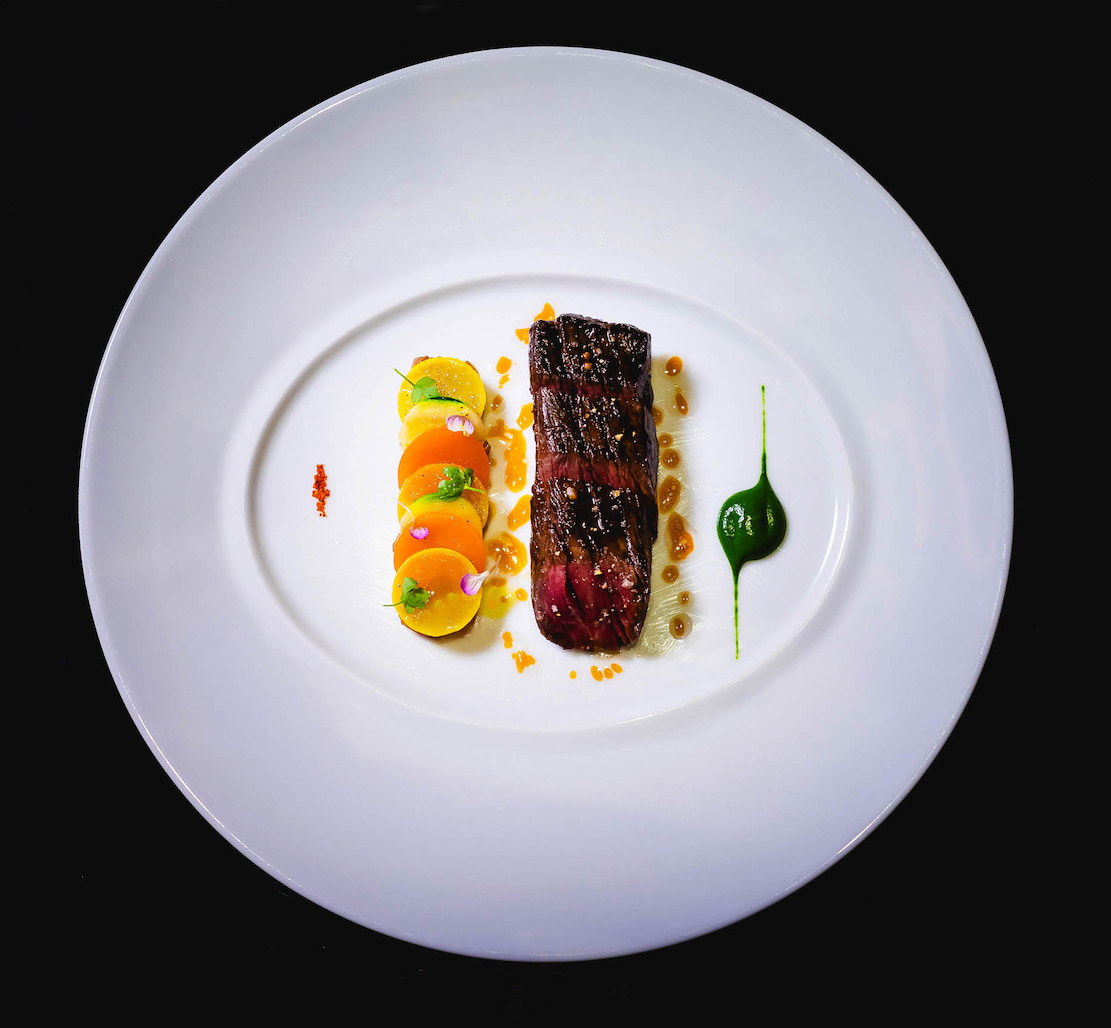 spiced,
with agave turnips and satsuma mandarine that
had just the right sweet-and-sour elements to
make this a modern version of canard à
l’orange ($46). Iberico pork had a great
deal of flavor on its own, succulent and sweet,
served with first-rate presa de
bellota ham, a mango aigre-doux
and a little minty Thai basil, with extremely
creamy jalapeño-laced pureed potatoes ($34).
spiced,
with agave turnips and satsuma mandarine that
had just the right sweet-and-sour elements to
make this a modern version of canard à
l’orange ($46). Iberico pork had a great
deal of flavor on its own, succulent and sweet,
served with first-rate presa de
bellota ham, a mango aigre-doux
and a little minty Thai basil, with extremely
creamy jalapeño-laced pureed potatoes ($34).
Bellanca employs no separate pastry chef,
but the desserts are as special as the rest of
his menu, beginning with a warm Manjari
chocolate tart with vanilla ice cream ($15) and
a crisp-to-the-touch
vacherin glacé with clementine marmalade,
refreshing citrus salad, and an orange
blossom-kaffir lime sorbet ($15). Caramelized
pineapple is set beneath a warm bomba rice
pudding and accompanied with Armagnac-splashed
raisin ice cream ($15).
Hot
soufflés are not easy to find in New York these
days, so Bellanca’s perfectly puffy version with
orange rum and green cardamom ice 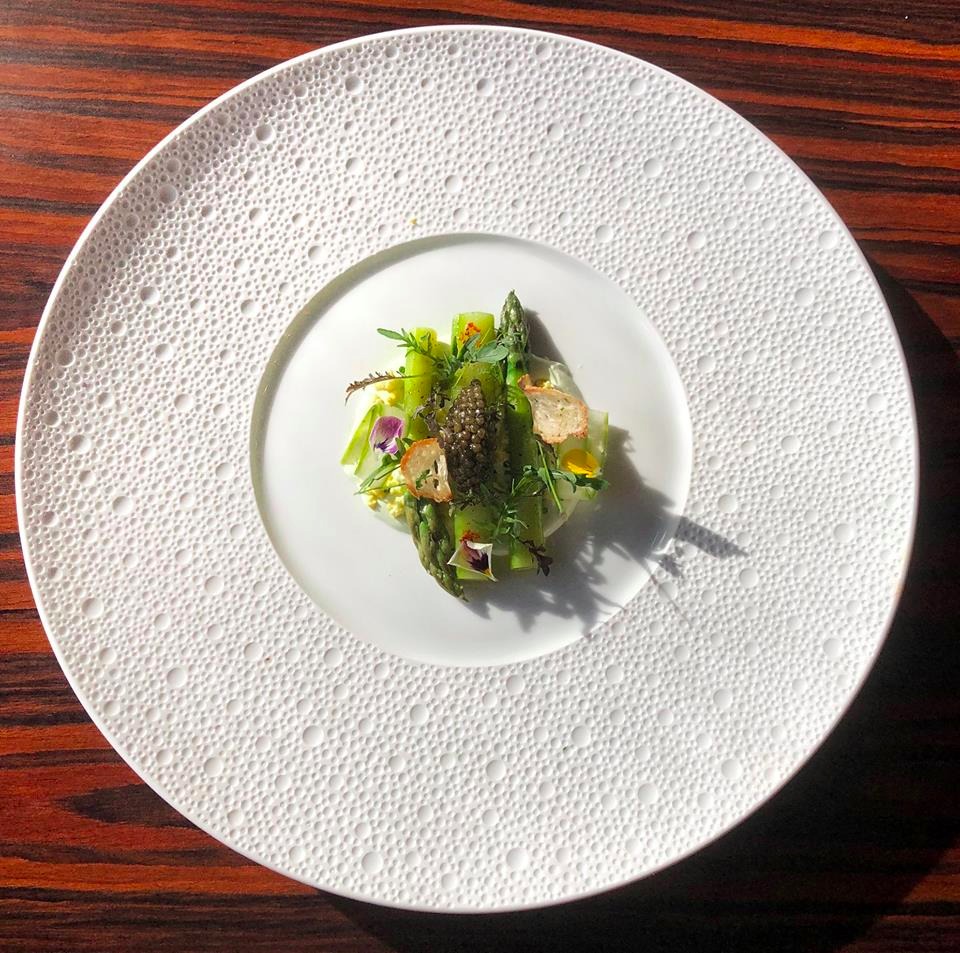 cream
makes it seem all new again ($15). For something
lighter there is an intense raspberry sorbet
with Meyer lemon and elderflower jus
($9).
cream
makes it seem all new again ($15). For something
lighter there is an intense raspberry sorbet
with Meyer lemon and elderflower jus
($9).
Clearly, this is not classic French
cuisine, though its underpinnings are based on
very carefully calibrated formulas learned over
decades in French kitchens now influenced by
other culture’s cooking.
The wine list is admirably wide-ranging,
with the French selections, as you’d expect, the
most abundant, but while there are some fine
choices under $100, there is a bewildering
number at $150 and way, way up, which is,
perhaps, the reason I didn’t see many wine
bottles on the surrounding dining room tables.
Putting
the vague word “Essential” before Bellanca’s
name doesn’t begin to tell you what to expect,
like saying “The Essential Sinatra.” When dining
at this level, you realize that the alteration
of one ingredient, or even the temperature by a
few degrees, would not provide the same unique
result Bellanca’s food delivers in course after
course. And
to do so at prices considerably below his
competitors’ is an added pleasure when you can
bask in such a beautiful and well-modulated
atmosphere where service exceeds expectations
without ever intruding.
Open
for dinner Tues.-Sat.
❖❖❖
GOING AFTER HARRY LIME
By John Mariani
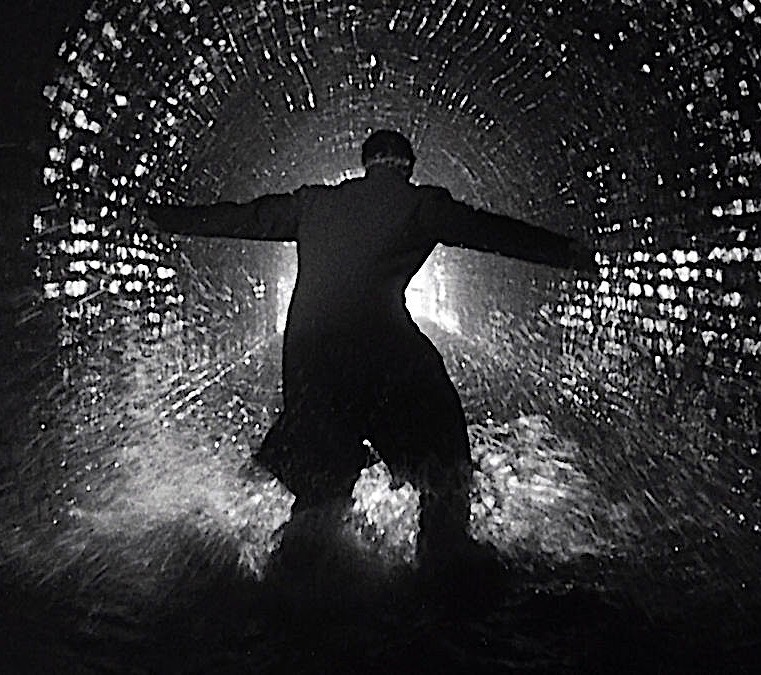
CHAPTER SIX
“We should have dug deeper than a grave.”—Major Callaway, The Third Man.
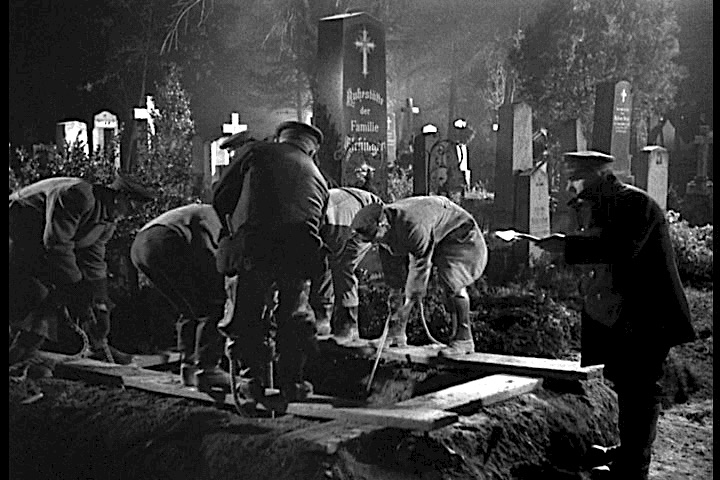
“I know you’re going to be disappointed,”
Gerald Kiley told David on the phone, “but those
files you’re looking for about post-war Austria
are not in
Lyon. I’m sure you were looking forward to a trip
to France.”
“Frankly,” said David, “I’m not sure this
whole project is going anywhere. But anyway, what
happened to the files, if they ever existed?”
“Well, that’s where you are in
luck. Whatever there is would be part of the
U.S.
Allied Commission for Austria Section files, and
those are all stored in Washington at the National
Archives (below). They
might be on microfiche or you might even take a
crack at searching the web. There are some pretty
decent search engines now. Ever try Yahoo!? Or
Lycos? They’re adding a shit load of stuff every
day.”
“I can’t say I’ve looked at them a whole
lot since I left NYPD, which had a pretty
good—whaddaya call them?—portals? You think the
National Archives are available that way?”
“Maybe. Worth typing it in. Let me know
what you find.”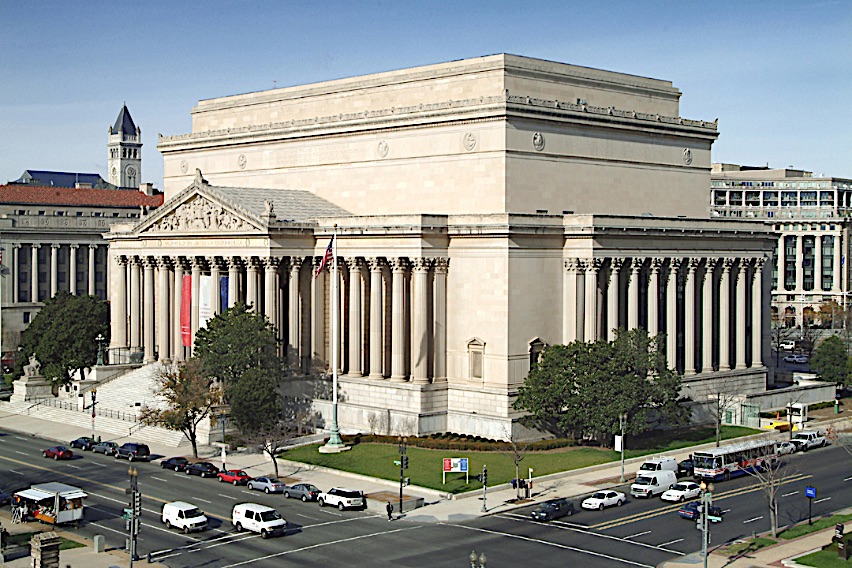
David hung up, made himself an espresso and
wished Katie were with him to help him with these
search engine things. But he started with Yahoo!,
typed in NATIONAL ARCHIVES, and was amazed to see
a page come up, with a slot to type in AUSTRIA
1945-1950. Again,
more pages, scores of them, detailing the
components of the military government established
on July 5, 1945, which shared oversight with their
Soviet, French and British counterparts. The
occupation was officially terminated July 27,
1955, by the State Treaty for the Re-establishment
of an Independent and Democratic Austria.
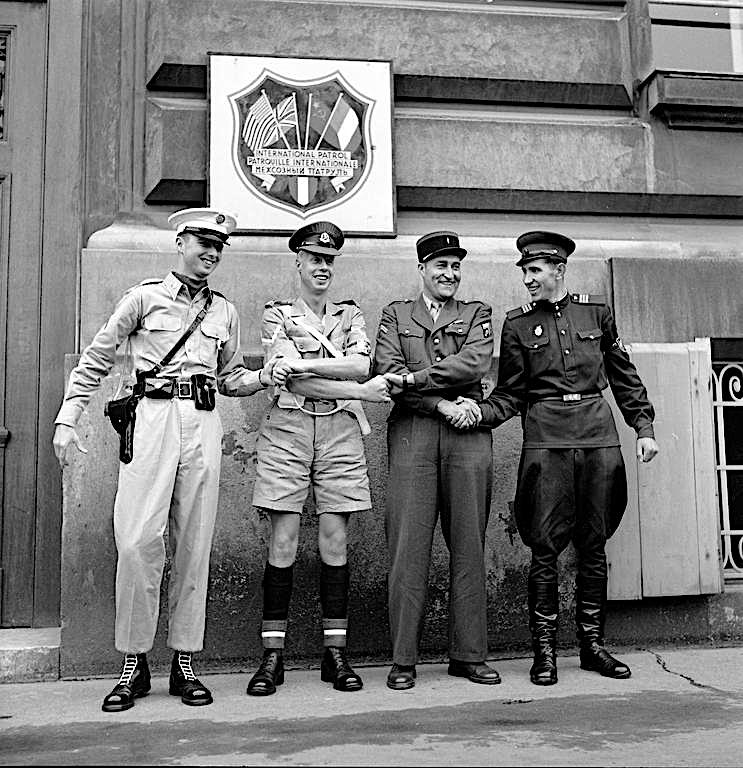 The majority of
the material seemed concerned with the finances of
post-war Austria, the transfer of funds, gold,
silver, jewelry and various currencies. Others
involved reports and investigations into crimes
relating to art objects encountered in the
re-opening of museums and libraries. Several
sections of the files were devoted to war crimes
and restitution. What followed were 300 pages and
thousands of files of names of individuals and
companies either making claims or being sued for
money and property—even “Horses of Misplaced
Persons.”
The majority of
the material seemed concerned with the finances of
post-war Austria, the transfer of funds, gold,
silver, jewelry and various currencies. Others
involved reports and investigations into crimes
relating to art objects encountered in the
re-opening of museums and libraries. Several
sections of the files were devoted to war crimes
and restitution. What followed were 300 pages and
thousands of files of names of individuals and
companies either making claims or being sued for
money and property—even “Horses of Misplaced
Persons.”
Further down were files on the Military
Police in Vienna, who were there to help
investigate the day-to-day crimes committed during
the Allied occupation, anything to do with U.S.
personnel, either as the cause or object of
criminal activity, including the black market.
From what he read, David sensed that the M.P.s
largely ignored prostitution and gambling
activities, and the black market dealings in food
and liquor seemed of minor importance to the
Americans, who found their Soviet and French
counterparts were often themselves involved in
many of those activities.
There was much more about drug trafficking
in the files, and it appeared the Americans and
British worked together on many of the cases
involving the selling of morphine. David found
nothing specific about an illegal market for
penicillin, though it might have been lumped in
with the other drug cases. As an experienced
detective, he knew that the much sought-after drug
in post-war Europe would certainly be worth a
great deal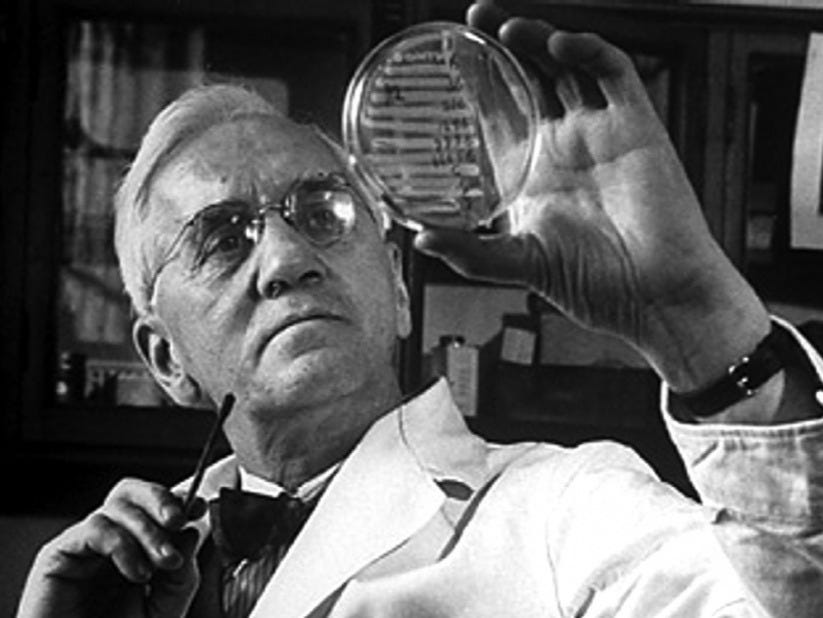 on the
black market, especially if it were diluted, as
the mobs often did with liquor during Prohibition,
and later with heroin and cocaine.
on the
black market, especially if it were diluted, as
the mobs often did with liquor during Prohibition,
and later with heroin and cocaine.
The fact was that
penicillin had been discovered by a Scottish
doctor named Alexander Fleming (right)
in 1928 but not used as an antibiotic until 1942;
even then it was difficult to make in large
supplies—by June of that year there was only
enough to treat ten patients. But
within two years U.S. laboratories began producing
penicillin on a mass scale, though the supply was
restricted to Americans and Allied troops, saving
perhaps millions of lives. Neither Germany, Italy,
Eastern Europe nor Japan had access to the drug,
resulting in many deaths from disease. The
shortage lingered well after the war was over,
thereby making its sale on the black market highly
desirable.
The files contained substantial lists of
criminals caught and gone free, separated into
categories. The list of those involved in the
black market was about a hundred names long, and
because David did not own a printer, he copied the
names out on a yellow legal pad. He then
checked off those described as deceased—none
executed, as he suspected there would be on
similar French and Russian lists—and those
imprisoned. He then figured if there were any
clues to a Harry Lime-type figure the list might
contain, he would zero in on those who were
operating before Graham Greene got to Vienna in
February of 1948.
His cut-down list contained every
nationality in Eastern Europe, Great Britain, and
the U.S., and each was identified by name,
nationality, and current whereabouts, with fewer
and fewer as of the 1950s.
Esther Hauptman. Austrian.
Incarcerated 9/14/46.
Hermann Strauss. Austrian. Deceased
10/10/1951.
Tomas Shumanov. Russian.
Whereabouts unknown 3/4/1949.
Michael Stern. German.
Whereabouts unknown.
Sigrid Schuster. Austrian.
Deceased 7/9/48.
Lionel Townes. British.
Incarcerated 6/8/1949.
Susanna Kroner. Austrian.
Deceased 12/3/1947.
Janos Szabor. Hungarian.
Whereabouts unknown.
Lazlo Horvat. Hungarian.
Deceased 11/11/1947.
Oskar Gurning. German.
Incarcerated 2/31/1946.
James Rodgers. American.
Incarcerated 4/6/1947
Harold Neame. British.
Whereabouts unknown.
Ingrid Spichler. Austrian.
Incarcerated 12/5/1947.
Gyorgy Specenkoff. Russian.
Whereabouts unknown.
Ernst Keller. German.
Deceased 11/6/1949.
William Walters. American.
Incarcerated 10/5/1947.
Stephen Berwick. British.
Incarcerated 4/18/1947.
Bela Czarky. Czechoslovakia.
Deceased 11/6/1949.
Herbert Shumann. Austrian.
Whereabouts unknown.
There were about fifty more names, and
David noticed that most of the Russians seemed to
have escaped capture, possibly escorted by the
Soviet police through the sewers of Vienna into
the Soviet zone. There were only two Americans,
both apprehended and incarcerated before Greene
got to Vienna. David suspected very few, if any,
of those who escaped were ever captured, for by
the time Austria was returned to the Austrians,
ferreting out black market activities had ceased
among the various Military Police. If such
criminal activities continued to flourish—and they
certainly did—it was now the business of the
Austrians.
David looked over
the list several times but could find nothing to
bring him closer to Graham Greene or Harry Lime,
and he felt bound to tell Katie as much. Maybe
there was a real Harry Lime, he thought, but
post-war Vienna was perhaps not the place to look.
He’d tell Katie that, but meanwhile he was open to
hearing what she was up to.
© John Mariani, 2016
❖❖❖
US WINE SALES' FUTURE SHOWS
HEADWINDS AND TAILWINDS
By John Mariani
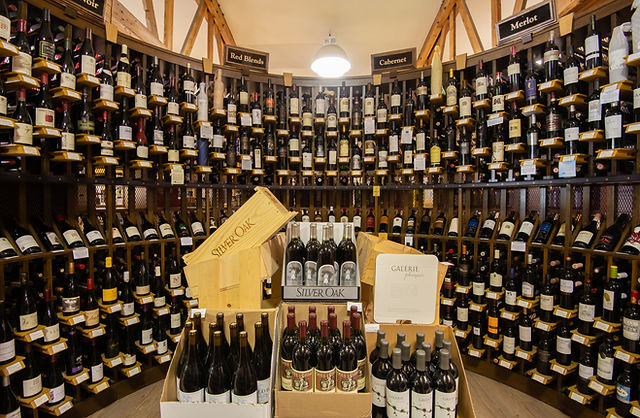
Do Americans really like
wine very much? Were you
to believe all the reality TV shows, it seems the
only thing the “Real Housewives” of Beverly Hills
(below), Atlanta and Miami do all day is
swig Champagne at al fresco lunches or poolside,
as does everyone in “White Lotus.” (Of course,
you’d expect that in a fictional comedy like
“Emily in Paris.”)
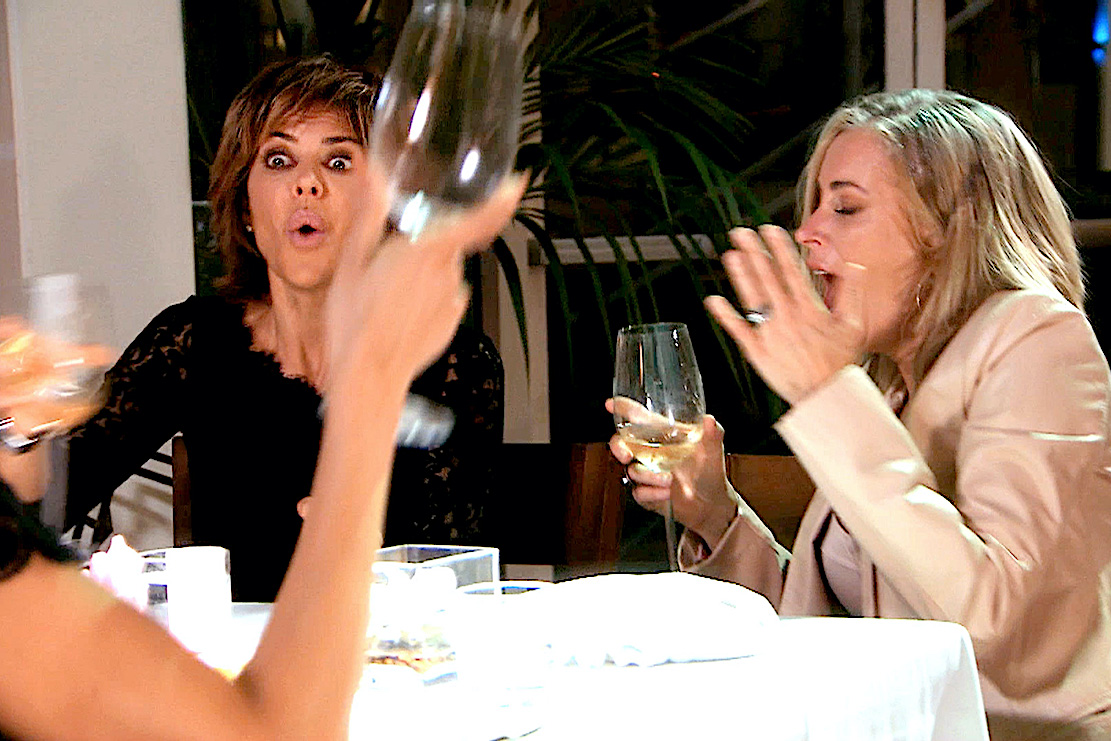 Depending
on whose stats you wish to believe, the U.S. wine
industry looks positively rosy. According to
Research and Markets’ 2022 “U.S. Wine Market Size,
Share & Trends Analysis Report by Project,”
sales of wine (domestic and imported) topped $66.97
billion, with
table wines dominating, followed by sparkling wines
(most domestic), whose projected sales will rise
7.7% from 2022 to 2030 and the U.S. wine market size
is expected to reach $115.03 billion by 2030.
Depending
on whose stats you wish to believe, the U.S. wine
industry looks positively rosy. According to
Research and Markets’ 2022 “U.S. Wine Market Size,
Share & Trends Analysis Report by Project,”
sales of wine (domestic and imported) topped $66.97
billion, with
table wines dominating, followed by sparkling wines
(most domestic), whose projected sales will rise
7.7% from 2022 to 2030 and the U.S. wine market size
is expected to reach $115.03 billion by 2030.
The report says the “rising worldwide supply
of grapes, increasing consolidation among producers,
distributors, and retailers, and a shift in
consumers’ drinking patterns are acting as major
drivers for the market.” So far so good.
But the respected annual, just released
“State of the US Wine Industry 2023,” by Rob McMilan
(below), EVP and  founder, Silicon
Valley Bank Wine Division, finds some distressing
flies in the barrel, reporting several areas for
concern in the market. For one, consumers older than
60 are the only growth segment, while those under 60
have a lower share of consumption compared with
2007, when forecasts were that Millennials, Gen-Xers
and the rest would be drinking more wines and better
wines. This now seems to be reversed, with older
wine drinkers trading up to more expensive wines, a
trend call “premiumization.”
founder, Silicon
Valley Bank Wine Division, finds some distressing
flies in the barrel, reporting several areas for
concern in the market. For one, consumers older than
60 are the only growth segment, while those under 60
have a lower share of consumption compared with
2007, when forecasts were that Millennials, Gen-Xers
and the rest would be drinking more wines and better
wines. This now seems to be reversed, with older
wine drinkers trading up to more expensive wines, a
trend call “premiumization.”
In
the group of 21 to 29 year olds, 35% drink alcohol
but not wine, while only 28% of American consumers
overall drink alcohol. The majority of Americans
never or rarely touch the stuff.
What would seem good news enough to make
vintners dance in their vineyards may not be so good
after all. The heavy rains in California will likely
result in a much larger than normal harvest this
season, when there won’t be enough consumers wanting
to buy all that increased supply. Three smaller
vintages, owing to draught and other climatic
conditions, prior to the rains were actually
beneficial in reducing volume produced.
The better news
is that, according to the Silicon Valley Bank Peer
Group Analysis Database, sales of premium wines
(above $15 a bottle) are rising, but wine sold below
$15 continues to slide, resulting in a second year
of negative volume growth in the industry.
There is optimism, according to the bank,
that “the typical consumers of premium wine are
sitting on more than a trillion dollars in COVID
savings. Our customers have the capacity to use
their savings and discretionary income to buy wine
even in a soft economy.”
The
question remains whether enough of those consumers
will spend those dollars on wines, when inflation
has made everything from butter to burgers more
expensive.
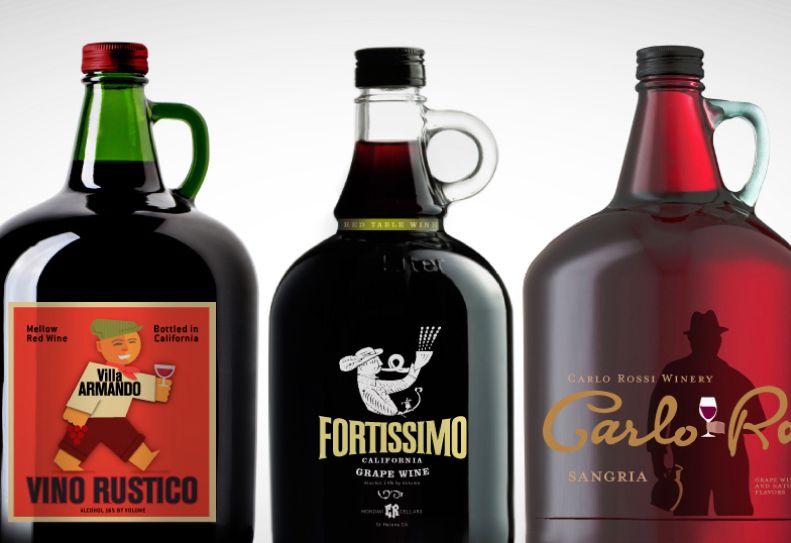 Americans continue to
drink a great deal more American wines than foreign,
but the lower end segment that produces jug, canned
and box wines and dirt cheap bottled wines under
five dollars, like Charles Shaw Merlot ($2.99), has
been dropping in popularity. And let’s face it, how
many people want to spend $15, or well above, to
drink a bottle of wine two or three times a week? I
have friends who call themselves “wine lovers” who
share a single bottle over an entire weekend.
Americans continue to
drink a great deal more American wines than foreign,
but the lower end segment that produces jug, canned
and box wines and dirt cheap bottled wines under
five dollars, like Charles Shaw Merlot ($2.99), has
been dropping in popularity. And let’s face it, how
many people want to spend $15, or well above, to
drink a bottle of wine two or three times a week? I
have friends who call themselves “wine lovers” who
share a single bottle over an entire weekend.
Add to this the fact that there is so much wine
in the global market coming from an increasing
number of countries that the buyer has an enormous
range of wines to choose from at all price points.
Competition is fiercer than ever.
My own take on all these data is that 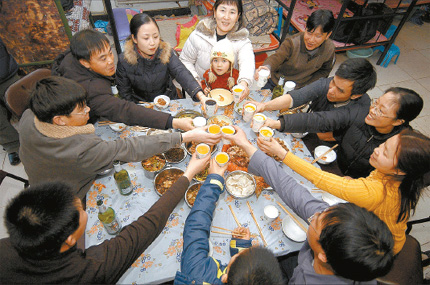 worldwide
consumption will remain more or less steady for the
next five years. Not only has the war in Ukraine
disabled shipment routes, but the crackdown in China
of what seems to be a deflating economy with a
disturbing drop in population and birth rates can
only blunt the excessive optimism of wine sellers
who thought that the China would be an inexhaustible
market as more of its people entered the middle
class and sought to imitate Western culture.
worldwide
consumption will remain more or less steady for the
next five years. Not only has the war in Ukraine
disabled shipment routes, but the crackdown in China
of what seems to be a deflating economy with a
disturbing drop in population and birth rates can
only blunt the excessive optimism of wine sellers
who thought that the China would be an inexhaustible
market as more of its people entered the middle
class and sought to imitate Western culture.
By the turn of the century the supply of wine
had outweighed the demand for something that is for
most people something of a luxury. Even the younger
generations in France and Italy, where wine has been
an ancient staple of the diet, are now shying away
from wine in favor of beer. Five, ten years from
now, who knows?
If
the future doesn’t look all that bright,
there is one one rosy spot: Sales of both still and
sparkling rosé wines are soaring, now accounting for
9.3% of the overall wine category.
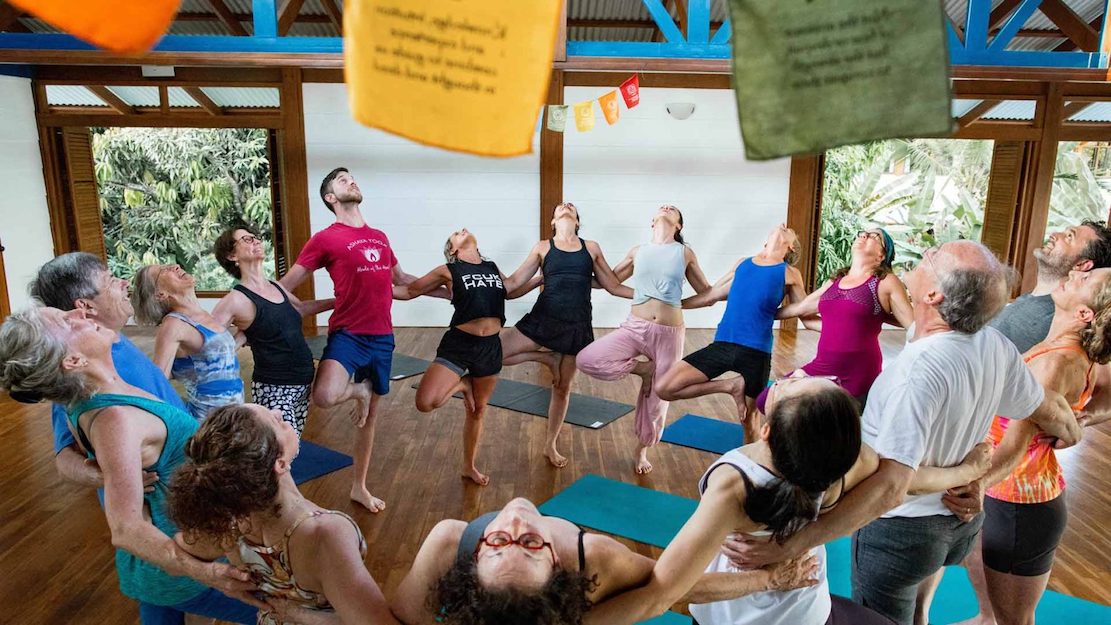
ARTICLES WE NEVER
STARTED READING
"The Bali Yoga Retreat Where Deodorant and Orgasms Are Banned."—London Times (1/27/23).
❖❖❖
Any of John Mariani's books below may be ordered from amazon.com.
 The Hound in Heaven
(21st Century Lion Books) is a novella, and
for anyone who loves dogs, Christmas, romance,
inspiration, even the supernatural, I hope you'll find
this to be a treasured favorite. The story
concerns how, after a New England teacher, his wife and
their two daughters adopt a stray puppy found in their
barn in northern Maine, their lives seem full of promise.
But when tragedy strikes, their wonderful dog Lazarus and
the spirit of Christmas are the only things that may bring
his master back from the edge of despair.
The Hound in Heaven
(21st Century Lion Books) is a novella, and
for anyone who loves dogs, Christmas, romance,
inspiration, even the supernatural, I hope you'll find
this to be a treasured favorite. The story
concerns how, after a New England teacher, his wife and
their two daughters adopt a stray puppy found in their
barn in northern Maine, their lives seem full of promise.
But when tragedy strikes, their wonderful dog Lazarus and
the spirit of Christmas are the only things that may bring
his master back from the edge of despair. WATCH THE VIDEO!
“What a huge surprise turn this story took! I was completely stunned! I truly enjoyed this book and its message.” – Actress Ali MacGraw
“He had me at Page One. The amount of heart, human insight, soul searching, and deft literary strength that John Mariani pours into this airtight novella is vertigo-inducing. Perhaps ‘wow’ would be the best comment.” – James Dalessandro, author of Bohemian Heart and 1906.
“John Mariani’s Hound in Heaven starts with a well-painted portrayal of an American family, along with the requisite dog. A surprise event flips the action of the novel and captures us for a voyage leading to a hopeful and heart-warming message. A page turning, one sitting read, it’s the perfect antidote for the winter and promotion of holiday celebration.” – Ann Pearlman, author of The Christmas Cookie Club and A Gift for my Sister.
“John Mariani’s concise, achingly beautiful novella pulls a literary rabbit out of a hat – a mash-up of the cosmic and the intimate, the tragic and the heart-warming – a Christmas tale for all ages, and all faiths. Read it to your children, read it to yourself… but read it. Early and often. Highly recommended.” – Jay Bonansinga, New York Times bestselling author of Pinkerton’s War, The Sinking of The Eastland, and The Walking Dead: The Road To Woodbury.
“Amazing things happen when you open your heart to an animal. The Hound in Heaven delivers a powerful story of healing that is forged in the spiritual relationship between a man and his best friend. The book brings a message of hope that can enrich our images of family, love, and loss.” – Dr. Barbara Royal, author of The Royal Treatment.
 |
The Encyclopedia of American Food and Drink by John F. Mariani (Bloomsbury USA, $35) Modesty forbids me to praise my own new book, but let me proudly say that it is an extensive revision of the 4th edition that appeared more than a decade ago, before locavores, molecular cuisine, modernist cuisine, the Food Network and so much more, now included. Word origins have been completely updated, as have per capita consumption and production stats. Most important, for the first time since publication in the 1980s, the book includes more than 100 biographies of Americans who have changed the way we cook, eat and drink -- from Fannie Farmer and Julia Child to Robert Mondavi and Thomas Keller. "This book is amazing! It has entries for everything from `abalone' to `zwieback,' plus more than 500 recipes for classic American dishes and drinks."--Devra First, The Boston Globe. "Much needed in any kitchen library."--Bon Appetit. |
"Eating Italian will never be the same after reading John Mariani's entertaining and savory gastronomical history of the cuisine of Italy and how it won over appetites worldwide. . . . This book is such a tasteful narrative that it will literally make you hungry for Italian food and arouse your appetite for gastronomical history."--Don Oldenburg, USA Today. "Italian
restaurants--some good, some glitzy--far
outnumber their French rivals. Many of
these establishments are zestfully described
in How Italian Food Conquered the World, an
entertaining and fact-filled chronicle by
food-and-wine correspondent John F.
Mariani."--Aram Bakshian Jr., Wall Street
Journal.
"Equal parts
history, sociology, gastronomy, and just
plain fun, How Italian Food Conquered the
World tells the captivating and delicious
story of the (let's face it) everybody's
favorite cuisine with clarity, verve and
more than one surprise."--Colman Andrews,
editorial director of The Daily
Meal.com. "A fantastic and fascinating
read, covering everything from the influence
of Venice's spice trade to the impact of
Italian immigrants in America and the
evolution of alta cucina. This book will
serve as a terrific resource to anyone
interested in the real story of Italian
food."--Mary Ann Esposito, host of PBS-TV's
Ciao
Italia. "John Mariani has written the
definitive history of how Italians won their
way into our hearts, minds, and
stomachs. It's a story of pleasure over
pomp and taste over technique."--Danny Meyer,
owner of NYC restaurants Union Square
Cafe, The Modern, and Maialino.
|
 |
 |
 |
 |
 |
 |
MARIANI'S VIRTUAL GOURMET
NEWSLETTER is published weekly. Publisher: John Mariani. Editor: Walter Bagley. Contributing Writers: Christopher
Mariani, Misha Mariani, John A. Curtas, Gerry Dawes, Geoff Kalish.
Contributing
Photographer: Galina Dargery. Technical
Advisor: Gerry
McLoughlin.
If you wish to subscribe to this
newsletter, please click here: http://www.johnmariani.com/subscribe/index.html
© copyright John Mariani 2023
